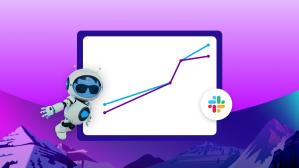From making supply chains traceable to securing sensitive medical data, much has been written about blockchain’s potential to transform the world in the Fourth Industrial Revolution. Blockchain facilitates next-generation transactions and record keeping with smart contracts and distributed, customizable ledgers. It holds so much promise that at business schools ranging from Berkeley to Wharton, students are flocking to classes on it. But how should organizations separate reality from the hype?
As CEO of the Global Blockchain Business Council (GBBC), Sandra Ro has a ringside view of the whole blockchain ecosystem. We caught up with her for a discussion on the impact of blockchain on business and how it can lend itself to a more “human-centric” approach to technology.
A recent Salesforce Research study showed that 72 percent of customers (consumers and business buyers) believe blockchain will transform their expectations of companies within the next five years. What’s behind the rise of blockchain and how do you see its potential?
The global financial crisis of 2007 and 2008 triggered a fundamental rethink about financial stability, the role of money, and the dependability of “trusted third parties” such as banks.
Blockchain is a technology that allows people to transact securely via a decentralized and transparent platform – without needing to rely on third party intermediaries. Its emergence some 10 years ago was a response to an erosion in trust in traditional institutions; it has inspired a new generation of solutions aimed at exploring novel ways to reduce financial risk and exchange assets cheaply and securely.
But its potential isn’t confined to financial services. I believe blockchain can drive profound change across a range of industries and sectors, re-imagining the way we do so many things. Right now, for example, the technology is poised to disrupt how we manage health records, fight voter fraud, and distribute welfare, to name just a few areas. The possibilities are endless.
You mention that blockchain’s infrastructure is both transparent and decentralized. Can you explain a little more about how it works?
Blockchain technology allows a business to create a decentralized digital record of transactions — a “distributed ledger,” in other words. The platform works via a network of people who help to execute transactions and maintain the ledger by offering their computational power.
Every new transaction is mathematically encrypted and added as a new “block” to a chain of existing – and previously verified – records. However, the only way to update the system is by consensus. Blockchain technology uses a special algorithm to validate blocks before they can be added to the chain, ensuring that ledger transactions only update when parties across the network agree on their validity and approve them. This consensus algorithm creates a permanent record where verified data cannot be altered without changing every previous data block. This makes the digital records in such systems much harder to tamper with and easier to audit.
Blockchain also allows participants to exchange and authenticate data without having to rely on a third-party authority, such as a bank, sitting at the center and enforcing compliance.
But how does this make blockchain networks superior to a regular database?
Many companies currently operate via siloed databases, where information is stored in multiple places and formats. That approach can have an impact on reliability and accuracy, with out-of-date records, lost data, and administrative errors adding cost through fees and delays. It can also create friction for businesses through redundant and onerous paperwork, and open up opportunities for fraud and crime.
A blockchain, by contrast, is like a giant real-time ledger that can be run on millions of computers — a shared and single source of truth. Transacting with customers is faster and cheaper because intermediaries aren’t required to authenticate transactions – that role is filled by the technology. This can help businesses streamline their processes and reduce costs.
On a public blockchain, the identity of network participants is pseudonymously concealed behind powerful cryptography. However, the transactions that each network participant makes are open to viewing. That means all transactions can be monitored transparently across the chain, which helps to reduce human error. Other advantages include more robust security, making blockchain networks more resilient to data tampering and cyberattacks. However, there are certain records that should not be public (for example, most financial transactions). Today, private, permissioned blockchains solve the issues around privacy in transactions, but, over time, public blockchains will respond to these challenges with nascent solutions like sidechains and zk-SNARKs, that allow parties to verify each others’ information without actually sharing the information itself.
What industries are likely to be most affected by blockchain?
The most-cited use cases involve the financial services sector. Over the last five years, blockchain’s potential to improve the efficiency, security, and transparency of digital transactions has attracted a huge swathe of startups eager to disrupt traditional players in this area. They’ve been deploying the technology to develop applications that aim, for example, to cut out the number of intermediaries involved in existing transaction processes such as stock exchanges, payment networks, and money transfer services. Their goal is to reduce complexity and cost. There’s also a major focus on developing blockchain solutions to counter fraud and ensure the integrity of data.
Obviously, all this has been a big wake-up call for banks and other financial institutions. As they try to understand these developments and their potential impact, we’re seeing them invest in blockchain. They’re setting up internal teams, investing in startups, and creating common initiatives to understand the potential and search for use cases that can be implemented with minimal risk.
One of these is the Post Trade Distributed Ledger Group, which recently merged with the GBBC, a leading trade association for the blockchain technology ecosystem. Since 2015, this “collaborative community” of financial institutions and prominent market infrastructure players has looked at ways to understand the impact of technologies such as blockchain on the post-trade space (that is, the processes businesses use to verify the details of a transaction once it has taken place). The group shares case studies and research on the feasibility and scalability of exciting new initiatives, such as the Australian Stock Exchange’s pioneering move to replace its legacy Clearing House Electronic Subregister System (CHESS) platform with a distributed ledger technology-enabled solution.
What are some of the most innovative applications of blockchain that you’re currently excited about?
My personal bias is for human-centric technology — that is, technology that solves real-world problems and alleviates human suffering, and isn’t just “tech for tech’s sake.”
We’re seeing a lot of exciting use cases in this regard that are built on blockchain technology. Take the United Nations’ World Food Programme (WFP), which has a number of blockchain-based initiatives running to help it distribute humanitarian aid. In Jordan, for example, the WFP has been giving out vouchers based on cryptocurrencies to Syrian refugees, who use them to purchase food and other necessities. The organization records all entitlements on a blockchain-based computing platform, which allows it to speed up transactions while lowering the risk of fraud or data mismanagement.
Other organizations are using blockchain-based applications to give displaced Rohingya people secure digital identities. Refugees often find it impossible to access government services in countries where they have settled after being forced to flee their homelands, because they lack passports or official ID. With these use cases, a blockchain database is used to record individual digital IDs, which can then be issued to people once they have taken a test to verify that they are genuine Rohingya.
Are you also seeing the blockchain conversation start to widen out across a broader range of industry verticals?
Yes, over the last three years, we’ve seen many businesses look at verticals that they’ve not traditionally been involved in and think to themselves, “Well, actually, blockchain offers us an opportunity to get involved in this area. We could develop an application based on this technology where we could cut out the middleman and offer this service faster, cheaper, and more securely.” That’s led to a very wide range of efforts to augment the technology for use across industries.
Take healthcare, for example. We’re seeing blockchain startups looking to develop applications that can deliver such things as improved health data security, anonymized data pools for research companies, and new ways to fight counterfeit drugs.
Then there’s supply chain disruption. Blockchain technology can be used to monitor costs, labor, and even waste and emissions at every point of a supply chain. That has big implications for companies seeking to reduce inefficiencies, and add traceability and security in the way they manage complex supply chains.
How about the real estate sector?
We’re involved in some exciting discussions with businesses around efforts to “tokenize” real estate on a blockchain. The underlying concept here is that of the “token economy,” which is something blockchain enables.
Money is one way to denominate value, of course, but you can also create alternatives — such as digital tokens created on a blockchain as part of a decentralized software protocol. Some blockchain tokens, like bitcoin, function as a digital currency. But tokens can be used to digitally represent any kind of tangible asset, from cattle to gold. Companies using tokens accept them for their products and services but require customers to use or earn them in specific ways.
In terms of real estate, tokenized pieces of a property can be tracked and traded via a shared database. The tokens allow for “fractional ownership,” or the ability for a qualified real estate owner to split up their property and sell off equity stakes, should they need extra money.
Earlier, you touched on your personal bias for ‘human-centric’ technology. Could you say a little more about how blockchain technology could be harnessed to help create more equitable societies?
The promise of blockchain technology and tokenization is that it can open up access to trading and investing to anyone — activities that historically have been reserved for the wealthy few.
To continue with our real estate example, the token economy can help city leaders fund affordable housing. Here, citizens could be offered municipal bonds based on blockchain tokens that allow fractional ownership. More people can become property owners, in other words, with the purchase of assets in this way, and that can help us get to a more equitable place as a society.
I do feel that most Fortune 500 leaders have not stepped up as good corporate and societal citizens — there’s a lot more that they could do to help reduce inequality in the economic sector. Applications built around blockchain offer an avenue to explore that.
But tugging at business leaders’ heartstrings isn’t the issue here. Emerging as it did as a grassroots movement with openness, transparency, and “people power” at its core, blockchain technology also speaks to millennial and Gen Z values. If businesses want to appeal to this customer base, it also makes sound economic sense to pay attention to blockchain as it rises through our economic bloodstream.















